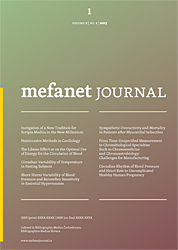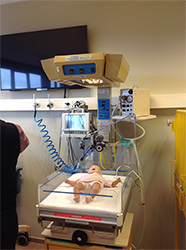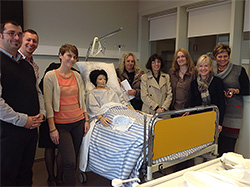
MEFANET Journal 2015; 3(2): 64-68
EDITORIAL MATERIAL
New teaching methods for practical training in nursing within the project Tempus IV – CCNURCA
Gabriela Kuriplachová1*, Dagmar Magurová1, Anna Hudáková2, Štefánia Andraščíková2, Ľubica Rybárová1
1 Department of Nursing, Faculty of Health Care, University of Presov in Presov, Slovakia
2 Department of Midwifery, Faculty of Health Care, University of Presov in Presov, Slovakia
* Corresponding author: gabriela.kuriplachova@unipo.sk
Abstract
Article history:
Received 2 December 2015
Revised 23 December 2015
Accepted 28 December 2015
Available online 30 December 2015
Download PDF
The aim of this article is to present new teaching methods for practical training in nursing within the project Tempus IV – CCNURCA (Competency based Curriculum Reform in Nursing and Healthcare in Western Balkan Universities) No. 544169-TEMPUS-1-2013-1-BE-TEMPUS-JPCR. Implementation of new practical teaching methods, such as learning with simulator mannequins, practical workshop, nursing process, mind mapping, case studies and problem-based learning (PBL) in practical training could help to improve the quality of the educational process in nursing at Universities of Western Balkan countries that have been involved in this project. The realistic conditions in simulation laboratories are reflecting real hospital and patient´s care, communication with patient and hospital staff, discussion and analysis of all student´s activities. The methods of next nursing generation in practical training that can help nurses to get used to the recognition and management of patients by using of simulated real life situations.
Keywords
Nursing; project CCNURCA; higher education; teaching methods; practical training; Bloom´s taxonomy
Introduction
Project TEMPUS IV is the European Union’s program which supports the modernization of higher education in countries of European Union. Project promotes institutional cooperation that involves European Union and partner countries and focuses on the reform and modernization of higher educational system including countries of Eastern Europe, Central Asia, Western Balkans and the Mediterranean countries [1].
Within this framework a consortium of universities, university colleges and governmental authorities engaged themselves in a project called “Competency based Curriculum Reform in Nursing and Healthcare in Western Balkan Universities" (CCNURCA). The project CCNURCA No. 544169-TEMPUS-1-2013-1-BE-TEMPUS-JPCR searched for interconnectivity in university educational system with European standards arising from Bologna process and the Lisbon strategy [2].
European Federation of Nurses (EFN) in collaboration with the International Council of Nurses (ICN) and with the World Health Organization (WHO) for European region established several basic principles in relation to nursing education in Europe, particularly condition of initial assessment for universities and 1st degree of university education as mandatory grade to carry out nursing practice in European countries [3].
Higher education in nursing has become a model for education in the Western Balkans, which supported the creation of project CCNURCA. In Slovakia, nursing is a study program administered by the Ministry of Education, Science, Research and Sports through which the graduate of the study program gains the professional ability/qualification to practice the profession or is prepared to continue in following university studies. The profile of studies is harmonized with the criteria of the European directives, enhanced by the adoption of the Declaration of Munich and implemented into the curriculum of educational institutions that provide this training [3].
Project CCNURCA started in 2013 and its plan is designed for 3 years. The main partner is educational institution HUB-KAHO in Belgium and co-operative institutions are Department of Nursing at the Faculty of Health Care University of Presov in Presov (Slovak Republic) and other 15 participating partners from Albania, Bosnia and Herzegovina, Switzerland, Netherlands, Serbia and Montenegro [2].
The 1st degree of university nursing education in Slovakia
Act of the National Council of Slovak Republic No. 131/2002 Coll. on Higher Education states that professionally orientated bachelor programs of the 1st degree of university nursing study focusing on acquisition of theoretical and practical knowledge whilst practicing, based on the present state of science and art with possibility to progress into 2nd degree and 3rd degree of university education [4].
Pursuant to Decree of Ministry of Health of Slovak Republic No. 364/2005 Coll. stipulates the extent of nursing practice provided by a nurse independently and in cooperation with a doctor and the extent of midwifery provided by a midwife independently and in cooperation with a doctor the competences of nurses were introduced into nursing practice [5].
University study of the 1st degree of nursing in Slovakia is compiled in accordance with the competencies of Directives 36/2005/EC and 2013/55/EU and the annex of Decree of the Government of Slovak Republic No. 296/2010 Coll. which govern professional qualification for performance of nursing occupation at universities in Slovakia [3,6,7].
Pursuant to Act of the Ministry of Health of Slovak Republic No. 455/2012 Coll. which amends and supplements Act No. 131/2002 Coll., the nursing study program in the 1st degree of university education consists of a set of courses which include education activities such as lectures, seminars, practicals, practical training, continuous clinical practice, summer clinical practice, project work, internship, field trip, final thesis, and state exam. The entire extent of study is minimum of 4 600 contact and non-contact hours, where half of it is practical education and a minimum of one third is theoretical education [8].
A condition to be met for student´s advancement to the next year is acquirement of prescribed number of credits in the individual years = 60 ECTS credits (European Credit Transfer System).
Each course of study program in nursing is evaluated by certain number of credits expressing student´s workload:
- Theoretical subjects (lectures, seminars and practicals) are converted to credits based on student workload: 1 ECTS = 25 hours student´s workload.
- Practical training (clinical training, clinical practice, continuous clinical practice, and summer clinical practice) is converted based on student workload: 1 ECTS = 30 hours student´s workload [7].
When creating educational objectives in teaching practice, it is necessary relate to applied findings of revised Bloom’s Taxonomy (2001), which focuses on cognitive knowledge and cognitive process [9].
Taxonomy identifies three “domains” of learning (cognitive domain, affective domain and psycho-motor domain), each of which is organized as a series of levels or pre-requisites. In the Cognitive domain, training for technicians may cover knowledge, comprehension and application, but not concern itself with analysis and above, whereas full professional training may be expected to include this and synthesis and evaluation as well (Figure 1). Bloom´s taxonomy is classification of learning objectives, forms and levels of student learning [10].
New training methods in Nursing within project CCNURCA
Objective of this article is to present the new teaching methods for practical training in nursing within project CCNURCA, because these methods should be beneficial to the professional nursing training. Testing of new teaching methods is next phase of this project during 4–6 months of years 2015–2016. Methods for the planned testing are set in the following text.
Practical workshop
The practical workshop is a form of educational activity in which the lecturer/assistant prepares topic, objective and program. Students go through a variety of techniques brainstorming, feedback and a use their own knowledge and experience to acquire skills that will be used in practice. Lecturer/assistant during the workshop organizes, supervises and assists students with their course. The practical workshop is meant to deepen the already acquired knowledge and skills. The output of the workshop is to fulfill the conditions specified topic and target. The workshop does not have a theoretical component, it is assumed that the student has a theoretical basis and is able to transfer theoretical knowledge into practical skills and it is necessary to activate cooperation among the participants of the workshop. The workshop can be prepared on the basis of various scientific and professional topics. It is recommended to prepare for approximately 60 minimum (one theme/topic) with an optimal number of 25 participants [11].
Case studies
The case studies a description of emergency/interesting clinical case/disease. It is used as a form of presentation, particularly in some biomedical and social sciences. In the event of case studies it is a deliberate choice. It may be oriented on the typical but also the specific, unique, individual and small-occurring cases. The role of case studies is the description of the case and it is based on its deep, intensive analysis and detailed interpretation. Case studies have potentials for measuring application of knowledge, analysis, problem-solving and evaluative skills. This method allows students to apply theory to practical situations. Marking criteria helps re-grading and feedback. Case study and its scope is individual and depends on the particular case. It is recommended to prepare for approximately 30–45 minutes (one clinical case/disease) with an optimal number of 3–4 participants [12].
Learning with simulator mannequins
Education with simulator mannequins in nursing is the use of interactive simulations of real-life clinical scenarios for the purpose of nursing training, education and assessment. This method uses mannequin simulations. Students use simulation models for training nursing procedures and skills at the first in the simulation laboratory (Figures 2 and 3). They then can work in hospitals with patients. They were originally used to support active learning strategies in self-directed learning and problem-based learning.
Nursing process
Nursing process is a systematic and rational method, which plans nursing intervention and provides nursing care. The aim of this method is to evaluate the patient's medical condition, actual and potential health problems, the level of health care, make a plan to assess the patient's needs and to provide specific nursing interventions to meet those needs. Nursing process has five phases. This process consists of the following phases: assessing the health problems of the patient, diagnosis, intervention planning, implementation and evaluation of interventions provided by the nursing care [13,14].
Mind mapping
Mapping makes the use of graphics and designs to understand complex relationships and possible outcomes of these relationships. In a nursing environment, it can help students to connect conditions with treatments and potential side effects. Mind mapping joins the critical thinking and case-based learning and presses onto a student to make a visual scheme of how to solve the patient problem. Concept and problem mapping can develop the ability to see problems in their mind’s eye and improve creative thinking ability of students. Nursing practice often calls for innovative thinking from practitioners and concept mapping can train students to meet this requirement. Mapping can be applied with equal effectiveness to both - individuals and groups. Concept maps are graphical tools for organizing and representing knowledge in networks of concepts and linking statements about a problem or subject [15].
Concept maps include concepts, usually enclosed in circles or boxes of some type and relationships between concepts or propositions, indicated by a connecting line and linking words between the concepts.
Problem-based learning
Principles of problem-based learning (PBL) are based on the fact that students are actively participating in helping plan, organizing and evaluating the problem solving process. It requires students to solve authentic, real-life open-ended problems with as many correct answers as possible. Objectives of the problem-based learning process are: Knowledges (theoretical and clinical), Skills (scientific reasoning, critical appraisal, information literacy, self-directed, lifelong learning) and Attitudes (value of teamwork, interpersonal skills, the importance of psycho-social issues) [2].
Control of practical training and evaluation of academic results
Assessment methods chosen at project program CCNURCA should enable students to demonstrate their achievement of learning outcomes, and enable them to be judged against relevant assessment criteria. These links should also be made clear to students. Evaluation of academic results of the student within the academic subject is carried out: through continuous controlling of academic results during the period of study (presentation of nursing process, evaluation of practical workshop...) and by practical exam for the given period of study. The teacher gives a grade for the completion of the subject. The grade expresses the quality of acquired knowledge and practical skills in accordance with the results of learning on the subject information sheet. The different approaches to learning have all been included in the history of curriculum design and implementation, for example cognitive, behavioral, constructivist and postmodern approaches to nursing and nurse education.
Credits are allocated to entire qualifications or study programs, as well as their educational components (such as modules, courses, placements, dissertation work, practice and laboratory work). Number of credits are to be credited for individual components, based on their weight in relation to the workload, which students must complete in a formal context to achieve the learning outcomes.
Conclusion
Good teaching methods, which are in accordance with proclaimed goals of study programs and final competencies which should be reached by graduates, are necessary for final reform and for creation of good educated doctors and nurses full of appropriate knowledge and skills.
New teaching methods for practical training within project CCNURCA could prove to be beneficial in the professional nursing training, for example realistic conditions in simulation laboratories are reflecting real hospital and patient´s care, communication with patient and hospital staff, discussion and analysis of all student´s activities.
This article includes teaching methods and principles applicable not only in teaching nurses, but can also be beneficial to teachers in other fields of study.
Conflict of interest statement
Neither author has any financial or personal relationship with people or organizations that could inappropriately influence (bias) their work.
References
1. Tempus IV. 2013. [on-line]. [2014-09-24]. Available at: <http://www.naep.cz/tempus>.
2. Project Deliverables. 2015. [on-line]. [2015-12-11]. Available at: <http://www.ccnurca.eu/content/project-deliverables>.
3. Kuriplachová G, Magurová M, Hloch S, Chattopadhyaya S. Effectiveness of education in nursing. Dhanbad: ISM, 2014.
4. Act of the National Council of the Slovak Republic No. 131/2002 Coll. on Higher Education and on Amendments and Supplements to Certain Acts as Amended by later regulations.
5. Decree of the Ministry of Health of Slovak Republic No. 364/2005 Coll., which determines the scope of nursing practice provided by nurses independently and in conjunction with a doctor and the scope of midwifery practice provided by midwives independently and in conjunction with a doctor (as amended by No. 470/2006 Coll.).
6. Decree of the Government of Slovak Republic No. 296/2010 Coll. on Professional Qualification for Performance of Health Service Occupation, the Method of Further Education of Health Professionals, System of Specialized Fields and System of Certified Working Activities.
7. European Directive 2013/55/EU of the European Parliament and of the Council of 20 November 2013 amending Directive 2005/36/EC on the recognition of professional qualifications and Regulation (EU).
8. Act of the Ministry of Health of Slovak Republic No. 455/2012 Coll. which amends and supplements Act No. 131/2002 Coll. on Higher Education and on Amendments and Supplements of Certain Acts as amended by later regulations.
9. Anderson L et al. A Taxonomy for Learning, Teaching a Assessing of Educational Objectives. New York: Longman, 2001. 352 p.
10. Atherton JS. Learning and Teaching; Bloom's taxonomy. 2013. [on-line]. [2015-11-29]. Available at: <http://www.learningandteaching.info/learning/bloomtax.htm>.
11. University of Presov, Faculty of Health Care. Podmienky pre absolvovanie predmetu. [on-line]. [2015-11-29]. Available at: < http://www.unipo.sk/fakulta-zdravotnictva/hodkri>.
12. Rybárová Ľ. Základy výskumu. Presov: University of Presov in Presov 2008.
13. Derňárová Ľ, Rybárová Ľ. Potreby človeka a ošetrovateľský proces I. Presov: University of Presov 2008.
14. Derňárová Ľ, Rybárová Ľ. Potreby človeka a ošetrovateľský proces II. Presov: University of Presov 2008.
15. Zormanová L. Výukové metody v pedagogice. Praha: Grada Publishing 2012.
Please cite as:
Kuriplachová G, Magurová D, Hudáková A, Andraščíková Š, Rybárová Ľ. New teaching methods for practical training in nursing within the project Tempus IV – CCNURCA. MEFANET Journal 2015; 3(2): 64-68. Available at WWW: http://mj.mefanet.cz/mj-20151202.
This is an open-access article distributed under the terms of the Creative Commons Attribution-NonCommercial-ShareAlike 3.0 License (http://creativecommons.org/licenses/by-nc-sa/3.0/), which permits unrestricted use, distribution, and reproduction in any medium, provided the original work, first published in the MEFANET Journal, is properly cited. The complete bibliographic information, a link to the original publication on http://www.mj.mefanet.cz/, as well as this copyright and license information must be included.
![Figure 1. Bloom´s taxonomy [10] Figure 1. Bloom´s taxonomy [10]](/res/image/vol3-iss2/20151202-fig01-thumb.jpg)












